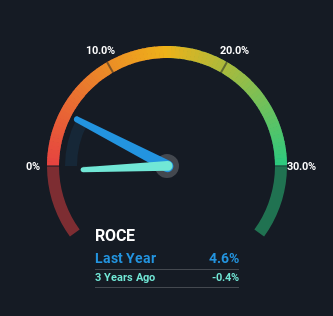K.C.P. Sugar and Industries (NSE:KCPSUGIND) Could Be Struggling To Allocate Capital
What trends should we look for it we want to identify stocks that can multiply in value over the long term? Firstly, we'll want to see a proven return on capital employed (ROCE) that is increasing, and secondly, an expanding base of capital employed. Ultimately, this demonstrates that it's a business that is reinvesting profits at increasing rates of return. Although, when we looked at K.C.P. Sugar and Industries (NSE:KCPSUGIND), it didn't seem to tick all of these boxes.
Return On Capital Employed (ROCE): What Is It?
For those that aren't sure what ROCE is, it measures the amount of pre-tax profits a company can generate from the capital employed in its business. To calculate this metric for K.C.P. Sugar and Industries, this is the formula:
Return on Capital Employed = Earnings Before Interest and Tax (EBIT) ÷ (Total Assets - Current Liabilities)
0.046 = ₹226m ÷ (₹5.9b - ₹959m) (Based on the trailing twelve months to December 2023).
Therefore, K.C.P. Sugar and Industries has an ROCE of 4.6%. Ultimately, that's a low return and it under-performs the Food industry average of 15%.
See our latest analysis for K.C.P. Sugar and Industries

Historical performance is a great place to start when researching a stock so above you can see the gauge for K.C.P. Sugar and Industries' ROCE against it's prior returns. If you're interested in investigating K.C.P. Sugar and Industries' past further, check out this free graph covering K.C.P. Sugar and Industries' past earnings, revenue and cash flow.
So How Is K.C.P. Sugar and Industries' ROCE Trending?
On the surface, the trend of ROCE at K.C.P. Sugar and Industries doesn't inspire confidence. To be more specific, ROCE has fallen from 7.9% over the last five years. However, given capital employed and revenue have both increased it appears that the business is currently pursuing growth, at the consequence of short term returns. And if the increased capital generates additional returns, the business, and thus shareholders, will benefit in the long run.
On a side note, K.C.P. Sugar and Industries has done well to pay down its current liabilities to 16% of total assets. That could partly explain why the ROCE has dropped. What's more, this can reduce some aspects of risk to the business because now the company's suppliers or short-term creditors are funding less of its operations. Some would claim this reduces the business' efficiency at generating ROCE since it is now funding more of the operations with its own money.
In Conclusion...
While returns have fallen for K.C.P. Sugar and Industries in recent times, we're encouraged to see that sales are growing and that the business is reinvesting in its operations. And the stock has done incredibly well with a 114% return over the last five years, so long term investors are no doubt ecstatic with that result. So while the underlying trends could already be accounted for by investors, we still think this stock is worth looking into further.
One more thing: We've identified 4 warning signs with K.C.P. Sugar and Industries (at least 1 which makes us a bit uncomfortable) , and understanding them would certainly be useful.
For those who like to invest in solid companies, check out this free list of companies with solid balance sheets and high returns on equity.
Valuation is complex, but we're here to simplify it.
Discover if K.C.P. Sugar and Industries might be undervalued or overvalued with our detailed analysis, featuring fair value estimates, potential risks, dividends, insider trades, and its financial condition.
Access Free AnalysisHave feedback on this article? Concerned about the content? Get in touch with us directly. Alternatively, email editorial-team (at) simplywallst.com.
This article by Simply Wall St is general in nature. We provide commentary based on historical data and analyst forecasts only using an unbiased methodology and our articles are not intended to be financial advice. It does not constitute a recommendation to buy or sell any stock, and does not take account of your objectives, or your financial situation. We aim to bring you long-term focused analysis driven by fundamental data. Note that our analysis may not factor in the latest price-sensitive company announcements or qualitative material. Simply Wall St has no position in any stocks mentioned.
About NSEI:KCPSUGIND
K.C.P. Sugar and Industries
Manufactures and sells sugar and related products in India.
Excellent balance sheet unattractive dividend payer.
Market Insights
Community Narratives



